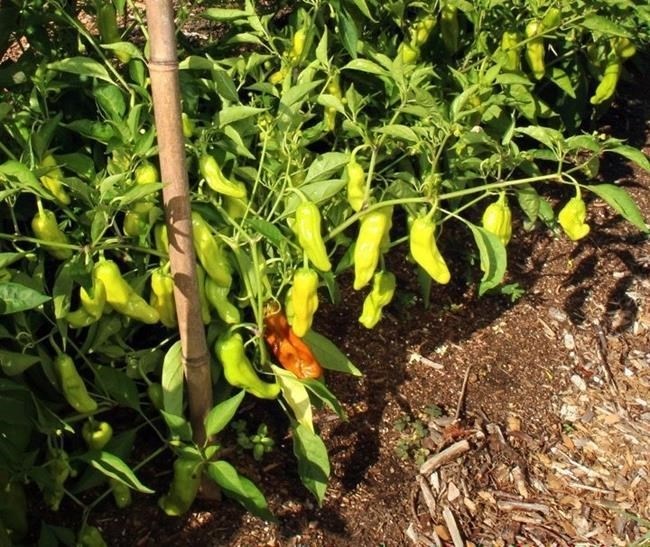
This Monday, Aug. 24, 2015 photo shows peperoncini peppers growing in a garden in New Paltz, N. Y. Whether red or green, Italian Peperoncini peppers are only mildly hot, but the red ones are hotter than the green ones.
Image Credit: Lee Reich via AP
September 07, 2015 - 8:30 AM
Ouch! Who would have thought that vegetable with the demur green skin could contain such bite?
But that's just a myth about peppers, that red means hot and green means not. Red just means ripe and green means unripe.
Hot or not, ripe means more flavourful. Peppers, like tomatoes, taste best fully ripened.
___
THE SOURCE OF THE HEAT
Hot peppers' hotness comes from compounds called capsaicins (kap-SAY-uh-sins), which have no flavour themselves. Capsaicins merely stimulate pain receptors, and the body's response is to speed up the heart and metabolism, and induce salivation and sweating. The two dozen or so different capsaicins vary in their effects: A habanero, for instance, bites you right away, then fades, while a jalapeño sneaks up on you with its hotness.
Why would any sane person eat something that produces pain? The reason might be that while the heart is racing and sweat is pouring out, the brain is also releasing endorphins to block the pepper pain. Endorphins induce a mild euphoria.
___
QUELLING THE FIRE
Sometimes peppers' hotness can, of course, be downright unpleasant. The fire can be quelled a number of ways — water or beer not among them.
Sugary or acidic compounds can moderate the heat, which makes a case for eating something sweet and sour along with something fiery. Capsaicins are fat-soluble, so the quickest way to turn down the heat is to shove some fatty food into your mouth. Milk protein also quells the fire, making full-fat dairy products useful to have on hand. Thus the use of sour cream and avocado in Mexican cuisine, yogurt in Indian cuisine and coconut in Thai cuisine.
The cool, green exterior of a green chili isn't the only thing that could fool a person unfamiliar with it. Your first, tentative nibble of a pepper is usually at its tip, which often isn't hot at all. Don't be fooled: A hot pepper's fire is mostly in its ribs and near the seeds. Some of that hotness also bleeds into the seeds themselves. So if you want to be spared the full hotness of a hot pepper, strip out the ribs and seeds before eating it.
Make sure to wash your hands thoroughly after you've worked with peppers because the capsaicins can cling to your fingers and be carried to your mouth, eyes or other sensitive parts of your body. And don't try to wash the hotness away with water. Milk is a convenient treatment, either as a wash or just patted on with a milk-soaked paper towel.
___
HOW HOT IS HOT?
In 1912, Wilbur Scoville came up with a method for quantifying pepper heat. He diluted a pepper and noted at what dilution hotness could still be detected. So a bell pepper chalks up zero Scoville units because it's not hot even eaten straight up. Poblanos are mildly hot (1,000 Scoville units), jalapeños are hotter (4,000), Thais hotter still (100,000) and habañeros top the scale with about 200,000 Scoville units. Mix one part habanero in 200,000 parts of water — equivalent to one drop in more than 2 1/2 gallons of water — and you'll still taste some hotness!
Scoville units are averages. Growing conditions can turn a pepper thermostat up or down, with more stress — hotter temperatures, or soil that is too wet or too dry, for example — generally resulting in hotter peppers.
Growing conditions have less influence on the bite from peppers with smaller fruits than from those with larger fruits.
Ripeness is also a factor, and red peppers of any variety will be hotter than green ones of the same variety. Still, any habañero, no matter what its ripeness or growing conditions, will get more endorphins pumping than will any red poblano.
___
Online:
http://www.leereich.com/blog
http://leereich.com/
News from © The Associated Press, 2015